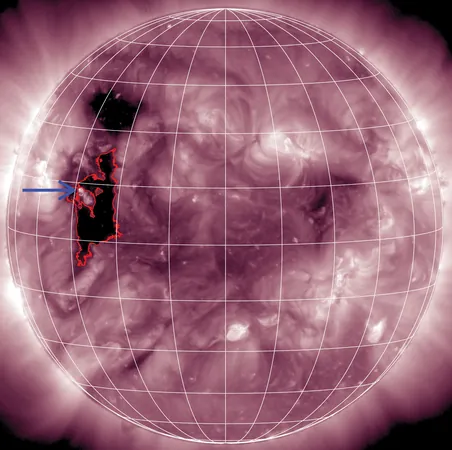
Astounding Solar Discovery: Scientists Uncover Unprecedented Concentration of Rare Helium Isotope!
2025-04-09
Author: John Tan
NASA's Solar Orbiter Makes Groundbreaking Findings
In a groundbreaking revelation, the NASA/ESA Solar Orbiter has recorded the highest-ever concentration of a rare helium isotope, 3He, emitted by the sun! This discovery is a monumental leap in our understanding of solar energetic particles (SEPs) that travel throughout our solar system.
A team from the Southwest Research Institute (SwRI) led by Dr. Radoslav Bucik embarked on a mission to uncover the origins of this unusual phenomenon. SEPs, which include high-energy particles such as protons and electrons, are typically linked to solar events like flares and coronal mass ejections.
The Mystery of 3He: An Isotope like No Other
What’s astonishing about 3He is its rarity in our solar system; it exists at a mere ratio of one 3He ion for every 2,500 4He ions. Dr. Bucik explained, "Solar jets seem to favor accelerating 3He to remarkable speeds, likely due to its distinct charge-to-mass ratio." This unique acceleration mechanism can enhance 3He abundance by a staggering 10,000 times its normal concentration.
But the Solar Orbiter went even further, capturing a jaw-dropping 200,000-fold increase in 3He! This isotope was not just abundant but was also accelerated to speeds far superior to those of heavier elements.
Peeling Back the Layers: The Source of 3He Emissions
In a study published in The Astrophysical Journal, the SwRI team identified the origins of these emissions with the help of high-resolution images from NASA's Solar Dynamics Observatory (SDO). They observed a small solar jet at the edge of a coronal hole, an area where magnetic field lines escape into space.
Interestingly, the magnetic fields in this area were surprisingly weak, resembling more those of calm solar regions rather than active ones. This supports previous theories that suggest 3He enrichment is more probable in weakly magnetized plasma.
A Twist in Solar Events: Uncommon Ion Abundance Patterns
This particular event also featured an unexpected twist: contrary to typical patterns where heavier ions like iron are more abundant, this time iron levels remained steady. Instead, elements such as carbon, nitrogen, silicon, and sulfur showed significant increases.
Given that scientists have only recorded 19 similar occurrences in the past 25 years, this event stands as not only unique but also perplexing in its implications.
The Importance of Proximity to the Sun
While the Parker Solar Probe was positioned to capitalize on the discovery, it was simply too far away to capture the event. This serves as a crucial reminder of the need for spacecraft closer to the sun to identify and examine these captivating phenomena, which promise to unlock more secrets about solar energetic particles.



 Brasil (PT)
Brasil (PT)
 Canada (EN)
Canada (EN)
 Chile (ES)
Chile (ES)
 Česko (CS)
Česko (CS)
 대한민국 (KO)
대한민국 (KO)
 España (ES)
España (ES)
 France (FR)
France (FR)
 Hong Kong (EN)
Hong Kong (EN)
 Italia (IT)
Italia (IT)
 日本 (JA)
日本 (JA)
 Magyarország (HU)
Magyarország (HU)
 Norge (NO)
Norge (NO)
 Polska (PL)
Polska (PL)
 Schweiz (DE)
Schweiz (DE)
 Singapore (EN)
Singapore (EN)
 Sverige (SV)
Sverige (SV)
 Suomi (FI)
Suomi (FI)
 Türkiye (TR)
Türkiye (TR)
 الإمارات العربية المتحدة (AR)
الإمارات العربية المتحدة (AR)